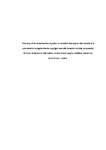Hidden Histories and Multiple Meanings: The Richard Dennett Collection at the Royal Albert Memorial Museum, Exeter.
| dc.contributor.supervisor | Pratt, Stephanie | |
| dc.contributor.author | Ayres, Sara Craig | |
| dc.contributor.other | Faculty of Arts, Humanities and Business | en_US |
| dc.date.accessioned | 2012-06-19T09:33:40Z | |
| dc.date.available | 2012-06-19T09:33:40Z | |
| dc.date.issued | 2012 | |
| dc.identifier | 10096940 | en_US |
| dc.identifier.uri | http://hdl.handle.net/10026.1/1039 | |
| dc.description | Associated forthcoming publication by same author about another Congo collection connected with Richard Dennett and Mary Kingsley: ‘Hidden Charms: Writing, On, Around and About a Congo Collection at the Pitt Rivers Museum.’ Journal of Museum Ethnography, no.25, (2012). | en_US |
| dc.description.abstract |
Ethnographic collections in western museums such as the Royal Albert Memorial Museum (RAMM) carry many meanings, but by definition, they represent an intercultural encounter. This history of this encounter is often lost, overlooked, or obscured, and yet it has bearing on how the objects in the collection have been interpreted and understood. This thesis uncovers the hidden history of one particular collection in the RAMM and examines the multiple meanings that have been attributed to the objects in the collection over time. The Richard Dennett Collection was made in Africa in the years when European powers began to colonise the Congo basin. Richard Edward Dennett (1857-1921) worked as a trader in the Lower Congo between 1879 and 1902. The collection was accessioned by the RAMM in 1889. The research contextualises the collection by making a close analysis of primary source material which was produced by the collector and by his contemporaries, and includes publications, correspondence, photographs and illustrations which have been studied in museums and archives in Europe and North America. Dennett was personally involved with key events in the colonial history of this part of Africa but he also studied the indigenous BaKongo community, recording his observations about their political and material culture. As a result he became involved in the institutions of anthropology and folklore in Britain which were attempting to explain, classify and interpret such cultures. Through examining Dennett’s history this research has been able to explore the Congo context, the indigenous society, and those European institutions which collected and interpreted BaKongo collections. The research has added considerably to the museum’s knowledge about this collection and its collector, and the study responds to the practical imperative implicit in a Collaborative Doctoral Project, by proposing a small temporary exhibition in the RAMM to explore these histories and meanings. In making this proposal the research considers the current curatorial debate concerning responsible approaches to colonial collections, and assesses some of the strategies that are being employed in museums today. | en_US |
| dc.description.sponsorship | AHRC | en_US |
| dc.language.iso | en | en_US |
| dc.publisher | University of Plymouth | en_US |
| dc.subject | Congo, collections | en_US |
| dc.subject | Congo Free State | |
| dc.subject | Congo Reform | |
| dc.subject | Ethnographic Displays | |
| dc.subject | Ancestor Spirits | |
| dc.subject | Museum | |
| dc.subject | Royal Albert Memorial Museum (RAMM) | |
| dc.subject | Ethnography | |
| dc.subject | BaKongo | |
| dc.subject | Colonial | |
| dc.subject | Kongo | |
| dc.subject | Kongo Political Culture | |
| dc.subject | Non-Western Art | |
| dc.subject | African Collections | |
| dc.subject | Folklore Society | |
| dc.subject | Curators | |
| dc.subject | Museum Representation | |
| dc.subject | Victorian Anthropology | |
| dc.subject | Minkisi | |
| dc.subject | Nkisi | |
| dc.subject | Nganga | |
| dc.subject | Banganga | |
| dc.subject | Ndungu | |
| dc.subject | Badungu | |
| dc.title | Hidden Histories and Multiple Meanings: The Richard Dennett Collection at the Royal Albert Memorial Museum, Exeter. | en_US |
| dc.type | Thesis | |
| dc.identifier.doi | http://dx.doi.org/10.24382/1529 |
Files in this item
This item appears in the following Collection(s)
-
01 Research Theses Main Collection
Research Theses Main


